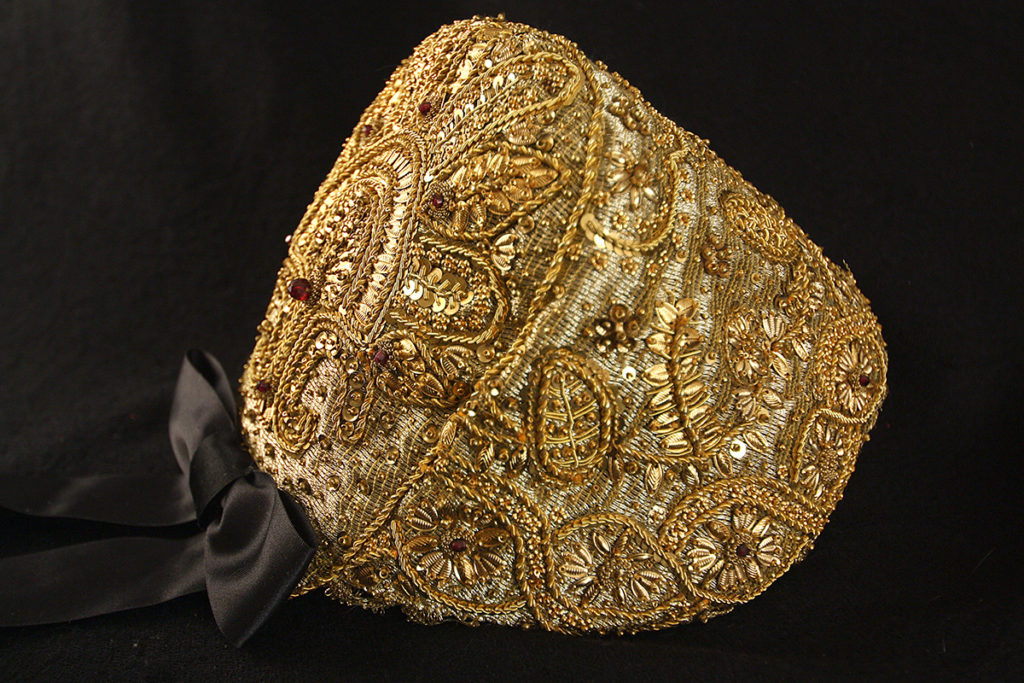Handcrafting the Digital
The pictures below show two pairs of knitted gloves with metal threads: one is a pair of liturgical papal gloves from the sixteenth century; the other pair is the Early Winter Night Biking Gloves. The liturgical papal gloves demonstrate skills and materials used in the sixteenth century, in this case, silk and metal threads in a knitted artefact, exquisite materials for high-ranked clerical officials. The Biking Gloves are equally knitted, using wool and metal thread, only this time the design was driven by electronic functionality and everyday use. While the coin cell and the LEDs included in the Biking Gloves are electronic components only developed in the twentieth century, the other materials and techniques used to build this interactive electronic glove have been available and practised for centuries.
Looking at the two pairs next to each other, one can imagine how the pattern from the sixteenth century could also fit the function of the Biking Gloves; how the golden rims on the fingers could be one conductive end of a switch, touching another finger or the palm of the hand to close the circuit. It becomes an intriguing thought experiment to consider the skills, materials, and patterns used in historic artefacts as potentially functional in the context of contemporary technology designs.

Pair of liturgical papal gloves, 16th century: silk, metal thread; knitted. Collection Albert Figdor (F237) Textile and Carpet Collection, MAK – Austrian Museum of Applied Arts / Contemporary Art

Early Winter Night Biking Gloves, 2010: wool, metal thread, LED, coin cell battery; knitted.
.
The next figure shows embroidery realizing an exclusive OR (XOR) gate. Next to it is a 7400 chip, a 14-pin IC (integrated circuit) containing four two-input NAND gates. It is optimized for mass production. The same chip can implement all logic gates and be inserted wherever a logic operation is needed in a circuit. It was widely used in mini- and mainframe computers between the 1960s and the 1980s and is still used today in various electronics applications. These two artefacts differ greatly in their materials, the routines, skills, time, and tools used to produce them, as well as their visual appearance. One is efficiently packaged, engineered for the widest possible application, mass-produced, and sealed in a black box. The other is laboriously crafted by hand, has a single function and is hardly usable in any commercial application; it is a unique artefact whose pattern reveals its function. Still, both have essentially the same use; both are integrated circuits, ICs10 that can implement a logic XOR function. For other logic functions, the legs of the chip need to be connected differently; in the embroidery, the pattern must change so the individual relays are reconnected to implement a different function. If the according changes are made, both are capable of implementing all logic gates. They become building blocks for any digital device.

Crafted Logic, XOR Gate, 2015: Hematite beads, metal thread, silver paint, cotton; embroidered
![]()
7400 chip, PDIP packaging; manufactured by Texas Instruments. The chip is approximately the size of a single bead used in the embroidery above. Photograph by Wikimedia Commons, Stefan506.
.
Having realized a single logic gate through textile crafting routines meant that eventually a computer could be embroidered if only the number of textile relays is increased and the pattern is designed to connect individual elements to fulfil necessary logic operations. To realize this, we turned to historic knowledge and materials. Austria used to have a strong, female-driven metal embroidery tradition producing artefacts for royal and bourgeois houses along with clerical garments. This led to dedicated schools, patterns, and course books, and shops, spreading the material during the monarchy. Finding suitable material still required a lot of testing, as the electronic quality of a metal thread is not something of historic importance, and thus not part of the knowledge traditionally passed on with the craft.
The pictures show a traditional artefact, a gold- embroidered hat, a traditional costume from northern Austria. Next to it is a detail of The Embroidered Computer, consisting of hundreds of connected textile relays. e material used in both examples is very similar, gold-wire bouillon and gold string, complemented with beads and sequins on the hat, and magnetic beads and golden copper wire in the case of the computer. The gold hat displays traditional motives, the detail of the computer shows a pattern evolving from the functional connections of individual relays, the gold strings being at the same decorative and conducting the signal between individual beads.

Linzer Mädchenhaube (traditional gold hat for an unmarried woman from the area of Linz, Austria), 1995: gold thread, gold bullion, paillettes, beads, embroidered by Anna Maria Pregartner. Photograph by Kati Pregartner.

Detail of The Embroidered Computer, 2018: gold thread, gold bullion, copper wire, beads; embroidered.